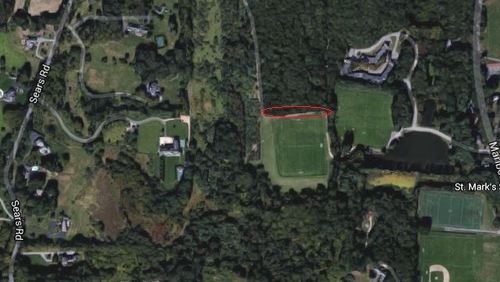Above: St. Mark’s moved their intended location to “just north” of a soccer field in response to neighbors’ complaints. (Image edited from Google Maps)
St. Mark’s School’s intention to install solar panels was one of the controversial topics in front of the Zoning Board of Appeals this week. (For news on other items, scroll to story end.)
The school got the ruling neighbors didn’t want. But it also shared news that I thought would make their plans less controversial – and yet it somehow didn’t.
The school was asking for the ZBA to confirm their right to install a large solar array in a residential zone. The board confirmed that the state’s Dover Amendment exempts them from zoning restrictions.*
In other words, they said the decision was out of their hands.
Neighbors have vocally opposed plans to install the panels beside Sears Road. The school responded to those objections by moving panels north of a soccer field, out of view of abutters. But without specific plans to review, many residents weren’t comforted.
Several residents spoke out as either concerned or outright angry about the school’s use of a “loophole”, a blanket ruling that wasn’t linked to specific plans, and that educational use isn’t the panels’ primary purpose.
The ZBA reiterated numerous times to neighbors’ questions that they were not the board in charge of plan specifics.
According to Town Counsel, concerns about the school’s plan should be addressed at future Planning Board Site Plan Review hearings.
St. Mark’s attorney, Ted Basset, referred the board to language in a past court ruling that says that facilities and structures don’t need to be directly used for education, just support the educational mission. He pointed out examples of educational uses that have been affirmed by rulings include power plants, cafeterias, dormitories, and parking garages.
The array would provide 25% of the electricity the school uses, which currently costs them. The school won’t be selling the electricity. Instead it will save on their about $500K electricity bill. But he also claimed the school is doing this out of their believed social responsibility to reduce their carbon footprint.
One resident, Brian Mongillo, pointed out the many trees currently located where the installation would go.
Mongillo opined that removing trees that absorb carbon dioxide to install the panels didn’t fit with “being green or teaching your kids what is right.” He suggested choosing a rooftop instead.
An attorney for residents tried making a legal argument against the ruling. Brian Charville argued based on case law that the structure should be educationally significant. ZBA members disagreed with the logic that a dormitory would be covered by law but power for the school wouldn’t.
For more background on the story, click here.
In other ZBA news . . .
A scheduled appeal of Fay School’s athletic field was delayed at the last minute. (Apparently, the Fay School’s attorney’s car broke down on his way to the meeting!) That is rescheduled for Tuesday, December 8, 7:30 pm in the Town House Hearing Room.
At the Park Central 40B hearing, the ZBA from town counsel through a letter. They learned that the Planning Board is allowed to hold a meeting to discuss a 40B, but it can’t bring in other boards or officials in to review it. Those kinds of hearings are restricted to the ZBA.
Chair Leo Bartolini said he would invite committees to come to their December 9th meeting if they wish to discuss the project.
Another letter was read from the Conservation Commission requested an extension on submitting comments.
The commission pointed out that the project is the biggest development Southborough has ever had, it is close to sensitive environmental areas, and plans are only 70% complete.
The board was advised by their MassHousing consultant that how to proceed comes down to a choice by the applicant.
Capital Group Properties can grant another extension to the ZBA on their final ruling. Otherwise, the ZBA can simply condition the project as subject to the Conservation Commission’s conditions. But with conditions not fully agreed on, that puts the developer at risk.
Developer Bill Depietri told the board he would let them know where he stands in the new year.
*(Though ZBA member, Thomas Bhisitkul noted that school facilities are still subject to reasonable regulations in terms of height, dimension, etc.)
Updated (12/8/15 7:38 am): I accidentally wrote carbon monoxide and instead of carbon dioxide above.



The above article incorrectly stated my comment at the meeting. Plants, through photosynthesis use carbon dioxide not carbon monoxide, thus reclaiming a major environmental greenhouse gas. This particular solar project has both negative and positive environmental implications. This is why I believe all options should be investigated before trees that took decades to become established are destroyed.
Sorry, that was a typo.
I found an interesting analysis looking at carbon savings with trees vs solar.
The conclusion he came up with is that an average New England roof array (average size and average efficiency) saves as much carbon as 50 trees. So from that (admittedly rough) calculation, we can assume that we’d get a good carbon savings, as there aren’t 50 mature trees in a plot of land that size. So the great news is that any solar array we put up is going to have a net benefit.
It’s also worth noting that ground arrays are both cheaper and more efficient than solar arrays, so the comparison would be even more favorable.
http://newenglandcleanenergy.com/energymiser/2015/09/24/tree-math-2-solar-vs-trees-whats-the-carbon-trade-off/
Meant to say above that “ground arrays are both cheaper and more efficient than roof arrays.”